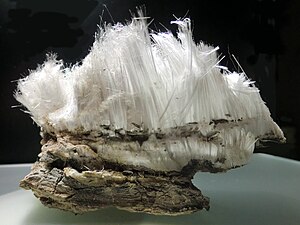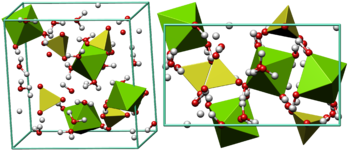Epsomite
| Epsomite | |
|---|---|
 | |
| General | |
| Category | Sulfate mineral |
| Formula (repeating unit) | MgSO4·7H2O |
| IMA symbol | Esm[1] |
| Strunz classification | 7.CB.40 |
| Dana classification | 29.6.11.1 |
| Crystal system | Orthorhombic |
| Crystal class | Disphenoidal (222) H-M symbol: (2 2 2) |
| Space group | P212121 |
| Unit cell | a = 11.86, b = 11.99 c = 6.858 [Å]; Z = 4 |
| Identification | |
| Color | White, grey, colorless, or pink, greenish |
| Crystal habit | Acicular to fibrous encrustations |
| Twinning | Rarely observed on {110} |
| Cleavage | {010} perfect {101} distinct |
| Fracture | Conchoidal |
| Mohs scale hardness | 2 |
| Luster | Vitreous, silky when fibrous |
| Diaphaneity | Transparent to translucent |
| Specific gravity | 1.67 - 1.68 |
| Optical properties | Biaxial (-) |
| Refractive index | nα = 1.433 nβ = 1.455 nγ = 1.461 |
| Birefringence | δ = 0.028 |
| 2V angle | Measured: 52° |
| Solubility | In water |
| Alters to | Dehydrates in dry air |
| References | [2][3][4] |
Epsomite, Epsom salt, or magnesium sulfate heptahydrate, is a hydrous magnesium sulfate mineral with formula MgSO4·7H2O.
Epsomite crystallizes in the orthorhombic system as rarely found acicular or fibrous crystals, the normal form is as massive encrustations. It is colorless to white with tints of yellow, green and pink. The Mohs hardness is 2 to 2.5 and it has a low specific gravity of 1.67.
It is readily soluble in water. It absorbs water from the air and converts to hexahydrate with the loss of one water molecule and a switch to monoclinic structure.
Etymology
It was first systematically described in 1806 for an occurrence near Epsom, Surrey, England, after which it was named.
Discovery and occurrence
Epsomite forms as encrustations or efflorescences on limestone cavern walls and mine timbers and walls, rarely as volcanic fumarole deposits, and as rare beds in evaporite layers such as those found in certain bodies of salt water.[5] It occurs in association with melanterite, gypsum, halotrichite, pickeringite, alunogen, rozenite and mirabilite.[4]
Related minerals
The epsomite group includes solid solution series with morenosite (NiSO4·7H2O) and goslarite (ZnSO4·7H2O)[3]
Research
Research on topical magnesium (for example epsom salt baths) is very limited.[6][7][8]
References
- ^ Warr, L.N. (2021). "IMA–CNMNC approved mineral symbols". Mineralogical Magazine. 85 (3): 291–320. Bibcode:2021MinM...85..291W. doi:10.1180/mgm.2021.43. S2CID 235729616.
- ^ Webmineral data
- ^ a b Mindat.org
- ^ a b Handbook of Mineralogy
- ^ McGraw-Hill encyclopedia of science & technology (10th ed.). New York: McGraw-Hill. 2007. ISBN 9780071441438. OCLC 84152915.
- ^ "Epsom Salt: Benefits, Uses, and Side Effects". Healthline. 13 December 2018.
- ^ "Magnesium Oil Benefits: Forms, Benefits, Uses, and Risks". Healthline. 25 January 2021.
- ^ Rath, Linda. "Why Take an Epsom Salts Bath?". WebMD.
